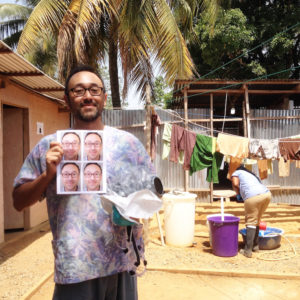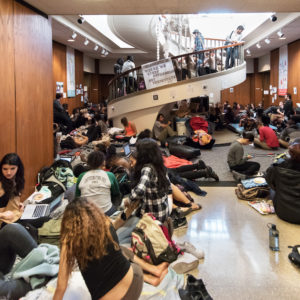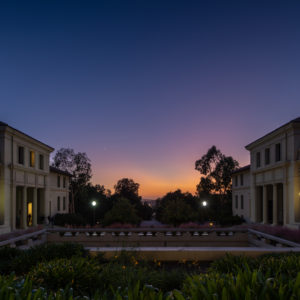
Marc Campos steadied himself on a small ledge as he stood in front of the Arthur G. Coons Administrative Building Oct. 29, trying to capture a ray of light. From atop the ledge, he steadied his camera tripod with an improvised setup consisting of a small stepladder he used along with the ledge to elevate his camera. The camera itself sat a few inches above his head. At one point, Campos used the front-facing camera of his iPhone to adjust a high-up control on the other camera.
From his position, Campos waited for the sun to descend. He did not have a formal goal for the shoot; instead, he tasked himself with capturing the sunset for the college to use in promotions.
“This could go nowhere or be completely overused,” Campos said.
As the sun lowered, Campos’ focus intensified. He would have only a brief amount of time to capture the image he wanted, and the light was fading fast.
Shoots like the one at the AGC make up a small portion of Campos’s work at Occidental. As the college’s dedicated photographer, his job entails capturing everything from sporting events to speeches; from the innards of the Johnson Student Center to 200 feet above upper campus; from the stacks of the Mary Norton Clapp Library to the country of Liberia. As a witness and documenter of the school’s history, Campos tells the story of Occidental one photo at a time.

A budding photographer
Campos, age 48, began as the school’s photographer in 2008, but his interest in photography dates back much further. According to Campos, he was first introduced to photography at Alta Loma Junior High School in his hometown of Rancho Cucamonga, CA. However, he could not see himself pursuing it as a profession; according to Campos, his parents did not support his interest until later in his career.
“I knew in my heart [photography] was what I wanted to do,” Campos said. “But I didn’t know that I should do it until later. But it just kind of nagged at me that I should be pursuing something more visual, something in the arts.”
Campos studied cultural anthropology and design while attending Chaffey College and Cal Poly Pomona. However, he continued to work on his photography skills and cited mentors from Chaffey as key to developing his skills.
Campos finally made the jump to the photography business after he was recommended to be a photo assistant for Visual Impact Studios, a commercial photography company. In his two years at Visual Impact, Campos said, he received a crash course on commercial photography, helping to shoot subjects ranging from nuts and bolts to landscapes. The job required Campos to be incredibly detail-oriented. He recalled one shoot in particular during which he was preparing a recreational vehicle (RV) for photos and had to make sure that all of the pieces of interior carpet faced the exact same direction.
Campos eventually realized that commercial photography was not for him and shifted gears to photojournalism, working for the San Bernardino Sun, the Inland Valley Daily Bulletin and the Inland Valley Voice over the span of 12 years. Campos said he documented a wide variety of news, including crime, entertainment and sports. The job required that he constantly remain attentive and responsive.
Campos said he looks back fondly on his time as a photojournalist. He appreciated the sense of community that came from working at a paper, in addition to serving the local communities that they reported on.
“You really bond with those people. You go through so much experience in life and you learn, make mistakes, you have achievements. And you all share in that, and that’s such a wonderful thing.”

Picturing Oxy
Campos’ career as a photojournalist ended unexpectedly after he was laid off in 2008. He continued to pursue photography as a freelancer for a time before being hired as Occidental’s first dedicated photographer that same year. Campos said that before him, the school relied on freelance photographers to take photos.
The transition from photojournalist to college photographer took some adjustment, Campos said, as he traded the fast-paced, constant work cycle of journalism for the slow, consistent pace of academia.
“That transition, hitting the brakes, it took a little bit of time,” Campos said. “I would hear sirens and I would have that urge to run towards it, to find out what’s happening and report on that.”
According to Campos, he applied to work at several positions. He chose Occidental based on the school’s unique character and culture.
“While I was interviewing and starting here, what drew me to Oxy was its quirkiness, its unique character,” Campos said. “It didn’t feel like just another college. It had its history, from Oswald to the campus characters.”
Campos likened working at Occidental to his time as a photojournalist. While he no longer devotes time to chasing the news, Campos said he enjoys how his work at Occidental contributes to a larger cause.
“I’m drawn to that. I’m not drawn to a corporate environment,” Campos said. “Working for a nonprofit, a place of higher ed, that means something. And I love that contribution to a greater good, just like a newspaper. You’re documenting and hopefully exposing something that needs fixing at a paper, and now it’s like advancing people for their lives.”
Campos occasionally worries that the same quirkiness and character that drew him to Occidental no longer exists as it once did.
“Maybe [Occidental] is just more organized now,” Campos said. “I think that’s it. Oxy is more organized because we have to compete with all the other colleges … and so perhaps we’re just getting better at what we’re doing. I hope we don’t lose the fabric, you know, the things that make a place interesting.”
As the school’s photographer, Campos’ day-to-day duties vary from taking portraits to capturing daily happenings like school events. During the week of Oct. 28–Nov. 3, Campos’ duties included taking sunset photos, documenting the annual Boo Bash in the Samuelson Pavilion and photographing a class visiting Special Collections in the library.
Occasionally, Campos’ work takes him to unique spots on campus. In order to take photos of the solar panels on upper campus, Campos said, he had to be raised in a crane nearly 200 feet above the ground. In another instance, he shot from the bell tower above the Johnson Student Center. According to Campos, this involved navigating through a narrow crawl space in order to reach the top. Campos also said he would like to photograph the Occidental Tunnels, but has yet to be given the chance.
Jeremy Bloom ’18, former video intern for the Occidental Admissions Office, occasionally collaborated with Campos while working at the school. Bloom said via email he remembers Campos as professional and courteous, and that Campos would even loan him equipment if he needed it. Even though he graduated, Bloom continues to work with Campos and Occidental on projects as a freelance editor, in part due to the rapport the two developed at the college.

A wider lens
Working at Occidental has led Campos on unexpected routes. According to Campos, one of the most memorable photography jobs as a result of the school took him far away from it — to Liberia in West Africa. For approximately a month in 2015, Campos worked with studio art professor Mary Beth Heffernan on her project and collaboration with health care workers confronting the country’s Ebola outbreak.
With the PPE Portrait Project, Heffernan sought to improve care for Ebola patients by humanizing the personal protective equipment (PPE), or hazmat suits, worn by healthcare workers. According to Heffernan, the suits conceal the majority of the wearer’s body and give them an off-putting appearance that could alienate patients. In response to the issue, Heffernan developed a solution that involved attaching portraits of the workers to their suits.
After a long process of securing funding, Heffernan finally had the resources to pursue her project. Campos’ inclusion in the project resulted from a chance meeting with Heffernan.
“I ran into Marc and I said, ‘Marc, it looks like I’m going to be doing this project, I’m going to Liberia’ and then I just said, ‘Do you want to come with me?’ And he said, ‘Yes,'” Heffernan said.
One month of extensive planning later, Heffernan and Campos arrived in Liberia, where they would spend the next month working with locals. According to Campos, the trip required a great deal of effort and training to stay healthy while simultaneously photographing in difficult conditions. Heffernan said that Campos devised an elaborate system of plastic wraps to keep his camera safe and capable of documenting the project in dangerous situations.
In order to document health care workers, Campos often accompanied them into dangerous “red zones,” Heffernan said. Despite the danger, Campos succeeded in documenting patients with workers in their modified PPEs.
“It’s thanks to him — and his willingness to get that training, and his willingness to take that risk — to get photos of patients actually using or responding to the portrait photos,” Heffernan said.
Heffernan said Campos did more than just take photos in Liberia — he actively engaged with the locals as well, as opposed to just documenting the epidemic.

“I think there was a kind of rare form of collaboration with Marc and the other health care workers,” Heffernan said. “Marc established relationships with all the health care workers. He spoke with them, and he got to know them. He showed curiosity about their lives. He, I would say, befriended them, and they befriended him, and so when he went in, I think they felt they trusted him.”
In 2017, Campos accompanied another trip abroad, this time to Costa Rica. According to biology professor Gretchen North, he followed Occidental students and professors as they performed research in and out of the rain forests of Costa Rica. Campos once again faced challenging conditions as he lugged gear through the humid forests and up observation towers.
According to North, Campos’ presence did not disrupt the work of the researchers.
“He’s just a participant, really,” North said. “The whole project includes recording it. So [his involvement], it’s not an add-on or anything that’s interfering and part of [the research]. We really missed him after he left.”
Heffernan also said that beyond documentation, Campos’ photos have also been useful in creating public awareness for the research and securing funding for future projects. His photos allow the school to tell the story of its previous research, Heffernan said, and make a good impression when applying for support.
“Compassion and trust”
Trips abroad aside, one of Campos’ favorite aspects of working at Occidental includes meeting and spending time with students. Campos cited the annual Dance Production (Dance Pro) as a highlight.
“I look forward to it every year,” Campos said. “It’s so great, capturing the expression of what the people are going through — typically, there’s that mix of fear and joy, and I love that.”
As dancers move gracefully across the stage, Campos said he must carry and operate as many as five cameras at a time in order to capture the performance. Since he cannot stand on stage, Campos manages several offstage remote cameras. He moves around to shoot from other angles with two more cameras.

Campos also said that his time as the school’s photographer coincided with several pivotal moments for the student body. He recalled taking photos at a campus event the night Barack Obama ’83 was elected president in 2008, which he said was a highlight.
“Now it’s like, ‘Oh, yeah, Obama was president,’” Campos said. “But at the time it was like, ‘This is amazing and totally possible.’ It really had that feeling of hope.”
Every year, Campos also documents Convocation and Commencement, the first major event for first year students and the final event for graduating seniors respectively. While the two events mark different points in a student’s career, Campos has noticed a similarity: a look of confusion as students enter new phases of their lives. Campos said first years appear confused as they transition from the regimented Orientation week to the freedom of college, while seniors shift seem disoriented from the routine of school to adulthood.

Campos’ time as photographer coincided with the 2015 AGC Occupation, during which students protested the administration with a list of institutional demands. According to Campos, the tense atmosphere presented a challenge as he worked to provide impartial documentation of the occupation and show the efforts of students, staff and faculty. Campos said that despite the stress and frustration of the occupation, he recalled how kindly he was treated as he worked.
Heffernan said Campos’ familiarity with students allowed him to document the the occupation.
“He was trusted to be allowed in on the inner parts of the occupation of the AGC,” Heffernan said. “I think that that is really an instance of showing how he could be working for Oxy, but also have this compassion and trust on the part of the students.”
Campos, Caitlin and Rocky
When not working at Occidental, Campos enjoys spending time with his wife Caitlin. The two married in 2018 and live in Pasadena, CA with their dog Rocky. Campos said that the two like to travel to an area and explore it. One time, Campos said, the two stumbled upon what appeared to be a McDonald’s while exploring San Bernardino, CA.
“It wasn’t, though,” Campos said. “It’s a McDonald’s museum. It’s the location of the first McDonald’s. It’s privately owned, and they just have their own collection of weird McDonald’s memorabilia. One of the things in there is supposedly the world’s largest or longest French fry.”
Campos also continues to take photos in his free time. One of Campos’ passion projects includes photographing banked track roller derby, where skaters compete on an angled track, and has volunteered to shoot since 2008. The conditions of the sport make it difficult to photograph, according to Campos, but he appreciates the challenge.
Willie Siau ‘18 documented Campos’ interest in roller derby for his Media Arts and Culture senior comprehensive project in a documentary titled “Marc.” Siau knew Campos from seeing him work on campus and from working together for La Encina Yearbook, but seeing Marc shoot roller derby proved revelatory.
“Seeing how he interacted with the skaters and staff there, how his familiar presence made for stellar yet intimate photographs, it became clear to me that the Marc I know from Oxy is the same everywhere else — at least professionally speaking,” Siau said via email. “I’m very thankful he let me capture his story on film, and that I can call him a mentor and a friend.”
Sunset
In front of the AGC at 6:39 p.m., Campos continued to wait for the perfect moment. Over time, he increased the delay on his camera from one second to six seconds — a big deal, according to Campos. The cloudless sky transitioned to almost complete darkness, with just a sliver of light on the horizon.
At 6:43 p.m., Campos concluded the shoot. According to Campos, he started the shoot at approximately 5:07 p.m., as noted by a timestamp on his first photo. Various interruptions disrupted the shoot — a police helicopter circled over, passerby strolled through and a professor stayed to chat. Campos also noted that the lack of cloud cover prevented the sunset from showing more.
Despite the issues, Campos remained calm and professional throughout the entire shoot. According to Heffernan, Campos displays the same dedication to photography whether he is photographing a sunset or a medical facility.
“Marc helped tell the story of [the PPE Portrait Project],” Heffernan said. “His photos are the thing that bring the project to life for other people. I am extremely grateful for Marc’s role in this project in his compassion, his calm, his generosity of spirit and his absolute professionalism and skill.”
For Siau, Campos’ amiability defines him as much as his professionalism.
“When I think of Marc, what comes to mind first was his familiar and friendly presence on campus, and the conversations we had about photography, journalism, school, and other life experiences,” Siau said via email.
Campos said he enjoys the human connections he has made in his years of photography, at Occidental and beyond.
“The best part of a newspaper was the sense of community and really digging deep with an area,” Campos said. “And that’s the same [at Occidental], the community and the readership, they’re the students and alums. That’s still the most important part of this job, and it fuels me.”
In the weeks after the Oct. 29 shoot, Campos edited the photos. While Campos noted that conditions during the shoot were not ideal, the results may tell a different story.

(Photo by Marc Campos, Occidental College Photographer)
![]()


































